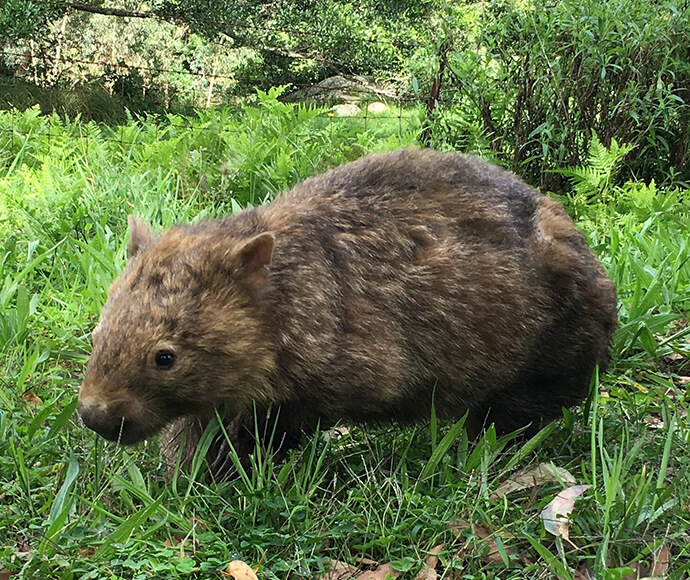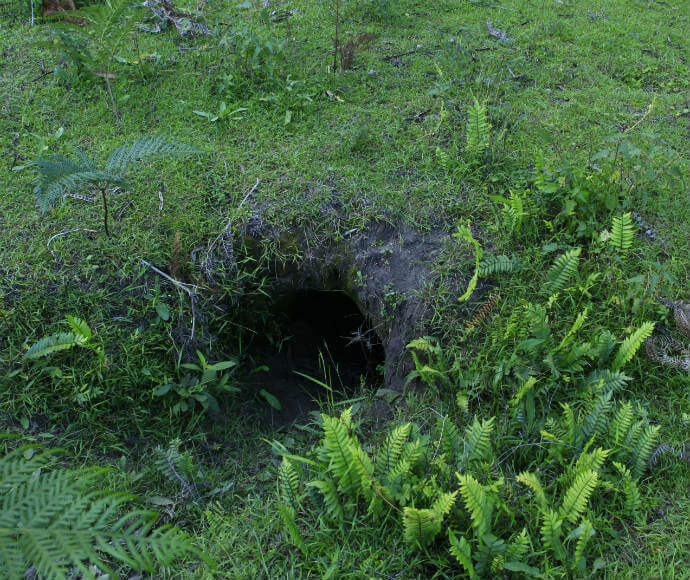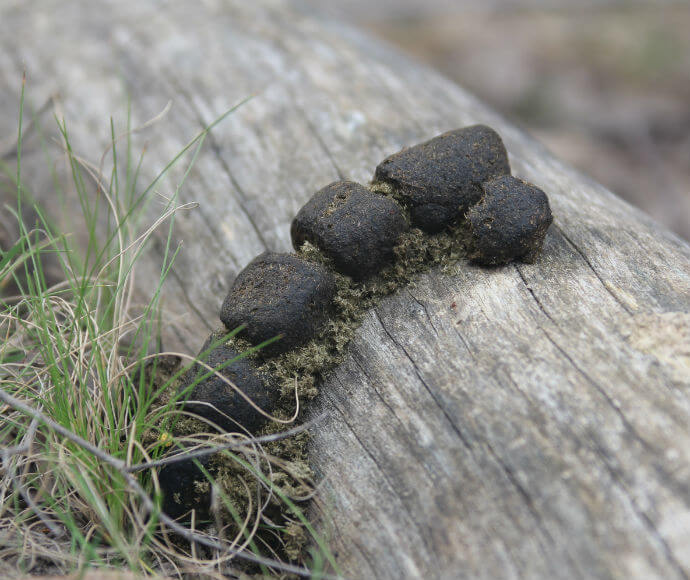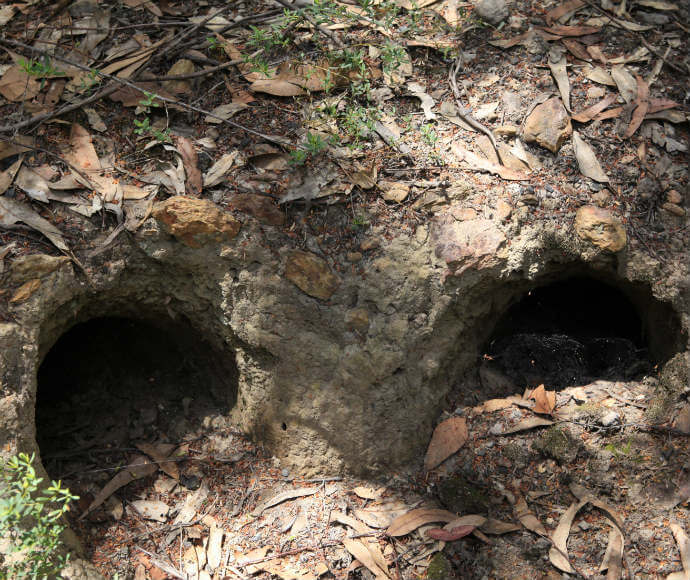Many of the problems between wombats and people can be resolved by learning about the behaviour of wombats and understanding their habitats and needs.
The bare-nosed wombat (Vombatus ursinus) is the species most frequently found in New South Wales. They prefer temperate forested areas of the coast, ranges and western slopes. Slopes above creeks and gullies are favoured sites for burrows and they like to feed in grassy clearings, including farm paddocks.
Bare-nosed wombat were once widespread from south-eastern Queensland, through New South Wales along the Great Dividing Range and most of Victoria. Their distribution in New South Wales is now fragmented and they are most abundant in the south-eastern parts of the state.
Remaining populations are under continued pressure from land clearing, road mortality, disease and illegal shooting. These pressures may be acute for some local populations.

The bare-nosed wombat are under pressure from land clearing, road mortality, disease and illegal shooting.
Understanding their habitat needs
Wombats construct burrows to escape the heat and hide from predators. They prefer areas where it is easy for them to dig. The burrows can be up to 30 metres long and several metres deep and are usually situated above creeks and gullies and may have multiple entrances.
Active burrows are often characterised by fresh cube-shaped droppings and scratch marks as well as freshly dug soil at the burrow entrance. Wombats will often build more than one burrow within their home range of 5 to 25 hectares.
Wombats are mostly solitary animals, but overlapping home ranges can occasionally result in a number of wombats using the same burrow. Wombats are possessive about their particular feeding grounds and they will mark out these areas by leaving scent trails and droppings. These markings are prominently placed on rocks and logs around the boundaries. If an intruding wombat encroaches on another’s territory it will be discouraged through a series of snorts and screeches and at times physical aggression.
Breeding occurs year-round, with each female typically producing one young. In some areas, however, wombats are seasonal breeders and may have dependent young in burrows from April to June. Young wombats take up to 21 months to reach full independence and 2 years to become sexually mature.

Wombat burrows can be 30 metres long and several metres deep.
Learning about their behaviour
Wombats become unpopular with landholders when they damage fences and infrastructure or trample gardens. Undetected burrows can be a hazard to livestock as they may trip or fall into burrows and injure themselves.
Many of the problems caused by wombats can be resolved with some patience and innovation. Landholders willing to share their property with wombats may find that there are simple solutions to most problems. For example, a post or small strand fence can be used to mark burrows in paddocks or driveways to keep stock away from burrow entrances.
Wombats use the same trails to get to and from their preferred feeding areas. Instead of going around an obstacle, such as a fence, a determined wombat will try to go through or under it instead. Installing ‘wombat swing gates’ at known wombat breech points along a fence will allow them to pass through a fence without damaging it. The fence will continue to exclude other animals such as wallabies, rabbits and foxes.
Removing the lowest fencing wire (15 centimetres above ground level) will also allow wombats to move through an area without damaging the fence. This is a much cheaper option than excluding them completely.

Fresh droppings are often a characteristic of active burrows.
Excluding wombats from your property
It is possible to exclude wombats from continuing to use a burrow that is under a building by erecting a one-way sturdy door that allows the animal to leave, but not to return. Steel mesh may need to be buried around the entrance of the burrow to prevent the wombat from digging under the door. Steel mesh can also be used to cover an empty wombat hole on a dam wall to reduce further burrowing at the site.
Another effective measure is to use 2 electric wires at 15 and 30 centimetres above ground level to prevent access to an area.
Using deterrents
Wombats may avoid the scent of predators. Placing a bag of organic fertiliser such as blood or dog urine near the entrance to a burrow may temporarily cause the wombat to vacate the burrow. In addition, these materials can be used to stop ‘scrapes’ and ‘test digs’ from becoming a new burrow.
Keep in mind, though, that a displaced wombat may subsequently burrow in a more undesirable location.
Increasing native vegetation
Wombats prefer to burrow in areas of vegetation and rocky debris. Land clearing has forced wombats to build burrows along creeks and drainage lines where vegetation still exists. Wombats are also often incorrectly blamed for causing erosion, which is more likely due to poor land management practices.
Planting trees and revegetating areas away from creeks can play a vital role in reducing wombat burrowing activity along creek beds. Retaining existing trees, logs and rocks, and establishing new areas of native vegetation, encourages wombats to construct burrows in less fragile areas and reduces the risk of erosion.
Can I bulldoze or infill a wombat burrow?
Only inactive burrows may be bulldozed. Bulldozing an active burrow can lead to wombats being buried alive and suffering a slow and painful death.
Even if you have found an apparently vacant burrow, you must not fill it in without confirming that it is inactive. Burrow activity can be confirmed by placing sticks across each entrance and checking (every day for at least a week) if these are disturbed.
Remember that, if you bulldoze an inactive burrow, the next wombat to enter your property may burrow in a more inconvenient place.
For more information about living with wombats contact your local national parks office or Local Land Services.

Only inactive wombat burrows may be bulldozed.
Relocating or harming wombats
The trapping and relocation of wombats is not permitted. This is because wombats are territorial animals and, if relocated, they are likely to be harassed or even killed by resident wombats.
Wombats are protected under the NSW Biodiversity Conservation Act 2016. It is an offence to harm a wombat unless a licence is obtained from the Department of Climate Change, Energy, the Environment and Water.
Protection of native animals
All native birds, reptiles, amphibians and mammals, but not including dingoes, are protected in New South Wales by the Biodiversity Conservation Act 2016.